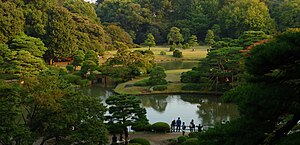Rikugi-en Gardens
| Rikugi-en | |
|---|---|
| 六義園 | |
 A view of the Rikugi-en Garden from the Fujishiro-toge hill | |
 | |
| Location | Bunkyo-ku, Tokyo |
| Area | 87,809.41 m2 (945,172.6 sq ft) |
| Created | 1938 |
| Operated by | Tokyo metropolitan parks |
| Parking | None |
| Public transit access | Komagome Station |
| Website | Official website Template:Ja icon |




Rikugi-en (六義園, [1]) is a Tokyo metropolitan park in Bunkyō-ku. The name Rikugi-en means Garden of the Six Principles of Poetry which comes from the idea of the six elements in waka poetry while en means garden or park. The park consists of a small pond, trees, and a hill. The traditional Japanese garden within the park is a tourist attraction.
History
The construction of the park took place between 1695 and 1702 and was headed by Yanagisawa Yoshiyasu by permission of the fifth Tokugawa shōgun Tokugawa Tsunayoshi and is a typical example of a garden from the Edo period. After the death of Yanagisawa it was neglected. The founder of Mitsubishi, Iwasaki Yatarō bought the garden in 1878 and restored it.[2]
In 1938, it was donated to the Tokyo City government. It was specified as a special place of scenic beauty (特別名勝, tokubetsu meishō) by the Japanese government in 1953.[3]
Access
The park is open from 9 a.m. to 5 p.m. It is a short walk from Komagome Station on the JR Yamanote line and the Tokyo Metro Namboku Line. There are no parking lots.
General admission (junior high school and above) is 300 yen. People over 65 pay 150 yen, and students under junior high school age (and junior high school students living or studying in the Tokyo metropolitan area) may enter for free.
Illuminations
For short periods during Spring and Autumn the cherry blossoms and Autumn foliage respectively are temporarily lit up and the park remains open until 9pm.[4]
See also
References
- ^ Easily misread as Rokugien, because Kanji 六 read as roku in Go-on (呉音) is basic knowledge among Japanese, but read as riku in kan-on (漢音) is not.
- ^ Mansfield. Page 87.
- ^ 東京都公園協会. 公園概要 (in Japanese). Archived from the original on September 27, 2009. Retrieved October 19, 2009.
{{cite web}}: Unknown parameter|deadurl=ignored (|url-status=suggested) (help) - ^ Hanaway, Tom Fall Evening Illumination at Rikugien Gardens September 24. 2014 The Japan Times Retrieved on March 23, 2016
Bibliography
- Mansfield, Stephen (2011). Japan's Master Gardens - Lessons in Space and Environment (Hardback). Tokyo, Rutland, Singapore: Tuttle. ISBN 978-4-8053-1128-8.
